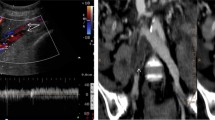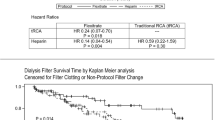Abstract.
Anticoagulation is usually indicated in patients receiving continuous renal replacement therapy (CRRT) to prevent clotting of the extra-corporeal circuit. While heparin is the most frequently used anticoagulant, regional citrate anticoagulation is becoming the preferred choice in those patients at high risk for bleeding. However, it has been widely claimed that to avoid citrate toxicity, CRRT with citrate anticoagulation should utilize diffusive clearance (e.g., continuous venovenous hemodialysis). We studied citrate clearance in five children who received citrate anticoagulation during CRRT with a COBE PRISMA machine and an M-60 (AN-69) filter. The blood flow rate ranged from 50 to 150 ml/min (2.1–8.0 ml/kg per min). Citrate was infused in the circuit circulation as an acid citrate dextrose (ACD) solution at a rate of 1.6–3.7% of the blood flow rate to maintain the circuit ionized calcium (iCa) <0.5 mmol/l. Calcium-free replacement fluid with reduced alkali (NaHCO3 20 mEq/l) was infused in pre-filter mode at a rate of 1,800–2,000 ml/h per 1.73 m2. In a separate central line, CaCl2 (0.8%) was infused (rate 25–50% of ACD infusion) to maintain systemic iCa between 1.0 and 1.3 mmol/l. Citrate concentration was measured using an enzymatic assay. Total CRRT duration was 1,224 h. Twenty-four filters were changed due to clotting, with a mean filter life of 51 h. Mean (range) citrate levels (mmol/l) were (1) before initiating CRRT (n=2): patient baseline 0.13 (0.1–0.15), (2) during CRRT (n=7): circuit 4.54 (3.95–6.25), effluent 4.31 (3.95–5.46), and patient 0.69 (0.30–1.13). Sieving coefficients for urea and citrate were 0.88–0.97 and 0.88–1.0, respectively. Citrate clearance (31–38 ml/min per 1.73 m2) was similar to that of urea (31–38 ml/min per 1.73 m2), and when evaluated in two patients, remained unchanged after substituting half of the convective clearance [continuous venovenous hemofiltration (CVVH)] by diffusive clearance [continuous venovenous hemodiafiltration (CVVHDF)]. The post-filter citrate load (mean±SD) delivered to the five patients during CRRT was 1.06±0.62 mmol/kg per hour. With the exception of alkalosis in one patient, no other complications were observed. Renal function recovered in all patients. We conclude that citrate anticoagulation in children is feasible, effective, and safe. Sufficient citrate clearance to prevent its toxic accumulation is achieved by convective clearance (CVVH) alone and diffusive clearance (CVVHDF) does not appear to be mandatory when utilizing citrate anticoagulation during CRRT.
Similar content being viewed by others
Author information
Authors and Affiliations
Additional information
Electronic Publication
Rights and permissions
About this article
Cite this article
Chadha, V., Garg, U., Warady, B.A. et al. Citrate clearance in children receiving continuous venovenous renal replacement therapy. Pediatr Nephrol 17, 819–824 (2002). https://doi.org/10.1007/s00467-002-0963-6
Received:
Revised:
Accepted:
Issue Date:
DOI: https://doi.org/10.1007/s00467-002-0963-6




